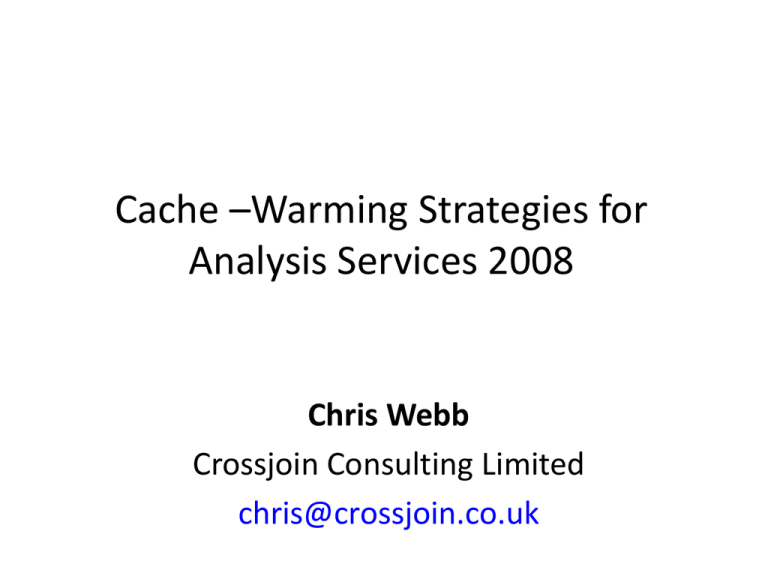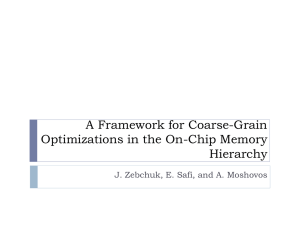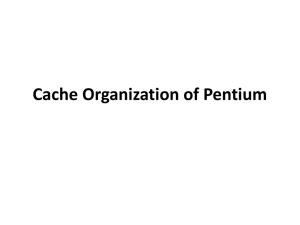Warming Strategies for Analysis Services 2008
advertisement

Cache –Warming Strategies for
Analysis Services 2008
Chris Webb
Crossjoin Consulting Limited
chris@crossjoin.co.uk
Agenda
• How Analysis Services caching works
• When and why Analysis Services can’t cache
data
• Warming the Storage Engine cache with the
CREATE CACHE statement
• Warming the Formula Engine cache by
running queries
• Automating cache warming
How Analysis Services answers queries
MDX Query In
Cellset Out
Cache
Query Subcube
Requests
Cache
Disk
Formula Engine
works out what data is
needed for each query,
and requests it from the
Storage Engine
Storage Engine
handles retrieval of
raw data from disk,
and any aggregation
required
Types of Analysis Services cache
• Analysis Services can therefore cache two types of value:
– Values returned by the Storage Engine
• ‘Raw’ measure values, one cache per measure group
• Dimension data, one cache per dimension
– Values returned by the Formula Engine
• Numeric values only – strings can’t be cached
• All SE caches have the same structure, known as the data
cache registry
• The FE can also store values in this structure if calculations
are evaluated in bulk mode
• The FE uses a different structure, the flat cache, for
calculations evaluated in cell-by-cell mode
Storage Engine Cache
• Data in the data cache registry is held in subcubes, ie
data at a common granularity
• Subcubes may not contain an entire granularity – they
may be filtered
• SE cache data can be aggregated to answer queries
– Except when the measure data itself cannot be
aggregated, for example with distinct count measures or
many-to-many
• Sometimes more data is fetched into cache than is
necessary for the query – this is known as ‘prefetching’
– Usually good for performance, but can cause problems
• Arbitrary-shaped subcubes cannot be cached
Formula Engine Cache Scopes
• There are three different ‘scopes’ or lifetimes of a FE cache:
– Query – for calculations defined in the WITH clause of a query,
the FE values can only be cached for the lifetime of the query
– Session – for calculations defined for a session, using the
CREATE MEMBER statement executed on the client, FE values
can only be cached for the lifetime of a session
– Global – for calculations defined in the cube’s MDX Script, FE
values can be cached until either
• Any kind of cube processing takes place
• A ClearCache XMLA command is executed
• Writeback is committed
• Global scope is best from a performance point of view!
Cache Sharing
• Values stored in the SE cache can always be shared
between all users
• Values stored in the FE cache can be shared between
users, except when:
– Stored in Query or Session-scoped caches
– Users belong to roles with different dimensions security
permissions
• Note: dynamic security always prevents cache sharing
• Calculations evaluated in bulk mode cannot reference
values stored in the FE flat cache
• Calculations evaluated in cell-by-cell mode cannot
reference values stored in the FE data cache registry
Forcing Query-scoping
• In certain circumstances, SSAS uses query-scoped FE
caches when you would expect it to use global scope
• These are:
– Calculations that use the Username or LookupCube
functions
– Calculations use non-deterministic functions such as Now()
or any SSAS stored procedures
– Queries that use subselects
– When any calculated member is defined in the WITH
clause, whether it is referenced or not in the query
– When cell security is used
Warming the SE cache
• Considerations for warming the SE cache:
– We want to avoid cache fragmentation, for example having
one unfiltered subcube cached rather than multiple
filtered subcubes
– It is possible to overfill the cache – the SE will stop looking
in the cache after it has searched 1000 subcubes
– We want to cache lower rather than higher granularities,
since the latter can be aggregated from the former in
memory
– We need a way of working out which granularities are
useful
Warming the SE cache
• We can warm the SE cache by using either:
– WITH CACHE, to warm the cache for a single query – not
very useful
– The CREATE CACHE command
• Remember that building aggregations is often a better
alternative to warming the SE cache
• But in some cases you can’t build aggregations – for example
when there are many-to-many relationships
CREATE CACHE
• Example CREATE CACHE statement:
CREATE CACHE
FOR [Adventure Works] AS
'({[Measures].[Internet Sales Amount]},
{[Date].[Date].[Date].MEMBERS},
{[Product].[Category].[Category].MEMBERS})'
Which subcubes should I cache?
• The Query Subcube and Query Subcube Verbose
events in Profiler show the subcubes requested
from the SE by the FE
• This is also the information stored in the SSAS
query log, stored in SQL Server
• Analyse this data manually and find the most
commonly-requested, lower-granularity subcubes
• Maybe also query the Query Log, or a Profiler
trace saved to SQL Server, to find other subcubes
– perhaps for queries that have been run recently
Warming the FE cache
• First, tune your calculations! Ensure use of bulk mode
where possible
• The only way to warm the FE cache is to run MDX
queries containing calculations
• Remember, these queries must not:
– Include a WITH clause
– Subselects
• Also, no point trying to cache calculations whose
values cannot be cached
• And think about how security can impact cache usage
Queries to warm the FE Cache
• Again, it is worth manually constructing some MDX queries yourself to
warm the FE cache
• Also, running regularly-used queries (for example those used in SSRS
reports) can be a good idea
• Can easily collect the queries your users are running by running a
Profiler trace, then saving that trace to SQL Server or a .trc file
– The Query Begin and Query End events contain the MDX query
– Need to filter out those with a WITH clause etc
– Watch out for parameterisation (eg SSRS)
– Watch out for use of session sets and calculations (eg Excel 2003)
– Watch out for queries that slice by Time, where the actual slicer
used may change regularly
– Think about the impact of dimension security too
Memory considerations
• SSAS caching can use a lot of memory!
• The cache will keep growing until SSAS thinks it is running
out of memory:
– When memory usage exceeds the % of available system
memory specified in the LowMemoryLimit property, data will be
dropped from cache
– When it exceeds the % specified in the TotalMemoryLimit
property, all data will be dropped from cache
– We therefore don’t want to exceed the LowMemoryLimit
– We also want to avoid paging
– We need to leave space for caching real user queries
• The FE flat cache is limited to 10% of the TotalMemoryLimit
– If it grows bigger than that, it is completely emptied
Automating Cache Warming
• We should perform cache-warming after cube
processing has taken place
• Remember – it may take a long time! It should not
overlap/interfere with real users querying
• We can automate it a number of different ways:
– Running SSRS reports on a data-driven subscription
– Using the ascmd.exe utility
– Building your own SSIS package – the best solution for
overall flexibility.
• Either fetch queries from a SQL Server table
• Or from a Profiler .trc file using the Konesans Trace File Source
component
Summary
• Clearly a lot of problems to watch out for!
• However, some cache-warming (however
inefficient) is often better than none at all
• A perfectly-tuned cube would have little need for
cache-warming, but...
– Some performance problems we just don’t know
about
– Some we may not be able to fix (eg with complex
calculations, hardware limitations)
– Cache warming is likely to have some positive impact
in these cases – maybe lots, maybe not much
Thank you…











